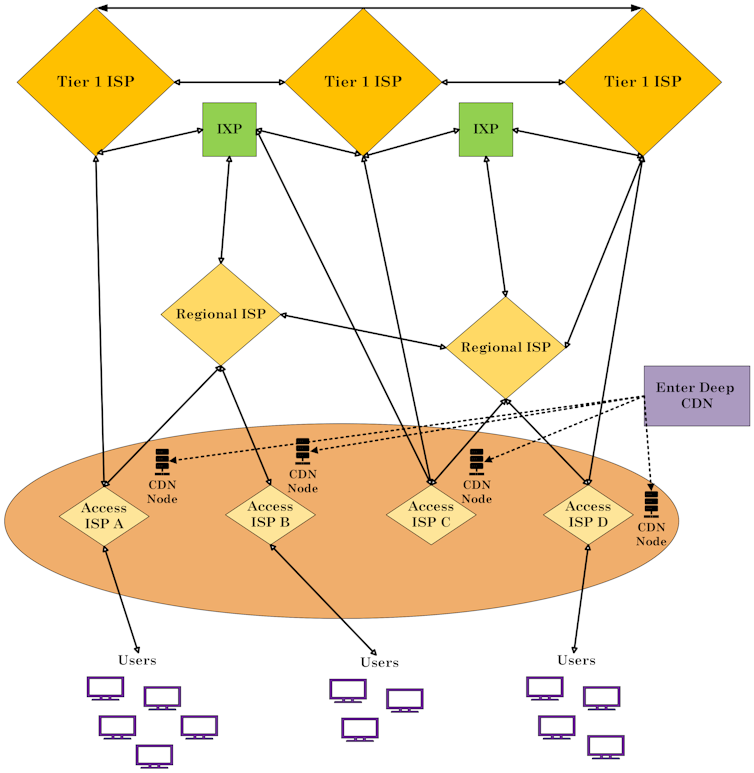## Level Up Your Understanding: How Streaming Tech Turns Pixels into Playtime
Ever wondered how your favorite streamers effortlessly share their epic gaming moments with thousands of viewers, all in crisp, real-time? It’s not magic, but it’s pretty darn close! Behind the scenes, a symphony of complex technology dances, weaving together data packets, compression algorithms, and powerful servers to deliver the magic of live gaming.

Geographic Latency and Network Congestion: Analyzing the Impact of Distance and Network Traffic on Streaming Performance
The Challenge of Global Delivery

Delivering video content on a massive scale, whether prerecorded or live, presents significant challenges. Imagine streaming services like YouTube, Hulu, and Netflix, each hosting vast libraries of on-demand content while simultaneously managing countless live streams worldwide. A seemingly straightforward approach would be to build a colossal data center to store all the videos and related content, then stream them to users globally via the internet. However, this method faces considerable obstacles.
One major issue is geographic latency. A user’s location relative to the data center directly impacts the delay they experience. If a data center resides in Virginia, a user in Washington, D.C., would encounter minimal delay. Conversely, a user in Australia would face considerably longer delays due to the increased distance and the data’s journey across multiple interconnected networks. This added travel time inevitably slows down content delivery.
Network Congestion: The Bottleneck of Bandwidth
Another problem arises from network congestion. As more users worldwide connect to the central data center, the interconnecting networks become increasingly burdened, leading to frustrating buffering and degraded streaming quality. Think of it like a highway during rush hour – increased traffic slows down everyone’s progress. Similarly, congested networks hinder the smooth flow of data, impacting the user’s streaming experience.
Mitigation Strategies: A Multi-pronged Approach
To address these challenges, streaming providers employ various mitigation strategies. One common approach is to distribute their content across multiple data centers strategically located globally. This reduces the distance data needs to travel, minimizing latency for users in different regions.
Additionally, streaming services leverage content delivery networks (CDNs). CDNs act as a network of servers strategically positioned around the world. When a user requests video content, the CDN directs the request to the server nearest to their location, ensuring faster delivery and reduced latency.
Furthermore, streaming platforms continuously monitor network conditions and adjust their delivery strategies accordingly. They might dynamically switch between different servers or alter the quality of the video stream to optimize performance based on real-time network traffic.
The Adaptive Stream: Your Personal Viewing Experience
Dynamic Stream Selection: Tailoring Quality to Your Connection
The beauty of streaming technology lies in its adaptability. Your streaming experience is not a one-size-fits-all approach. It’s dynamically tailored to your unique device capabilities and internet connection. When you request a video, the streaming platform analyzes your device’s screen resolution, internet speed, and other factors to determine the optimal quality and format for your viewing experience.
Buffering: Navigating Pauses for a Seamless Playback
Have you ever experienced a sudden pause in your video stream, followed by a brief moment of buffering? This phenomenon occurs when your device requests more video data than is immediately available. Streaming services constantly analyze your viewing patterns and predict your future data needs. When the system anticipates a demand spike, it proactively downloads additional video chunks in advance, ensuring a smooth playback experience.
Buffering is essential for maintaining a consistent viewing experience, especially when dealing with fluctuating internet speeds. It provides a temporary storage space for incoming video chunks, allowing the player to continue playing even if the network connection momentarily dips.
Quality vs. Bandwidth: The Balancing Act of Streaming
Streaming high-definition content demands substantial bandwidth, the amount of data that can be transmitted over a network in a given time. Choosing the optimal quality level involves a delicate balancing act. Streaming providers offer a range of quality options, from standard definition (SD) to high definition (HD) and even ultra-high definition (UHD) or 4K. Selecting a higher quality setting requires more bandwidth, potentially leading to buffering or choppy playback if your connection is insufficient.
Gamestanza understands the importance of delivering a seamless gaming experience. That’s why we prioritize optimizing our streaming technology to cater to the specific demands of online gaming. Whether it’s real-time strategy games, immersive RPGs, or competitive esports, we strive to provide a high-quality, lag-free streaming experience that enhances your gameplay.
The Future of Streaming: Innovation and Beyond
Emerging Technologies: Pioneering a New Era of Streaming
The world of streaming is constantly evolving, driven by continuous innovation and technological advancements. The following are some exciting emerging technologies poised to revolutionize the streaming landscape:
- AI-powered Encoding: Artificial intelligence algorithms are being employed to optimize video encoding, resulting in smaller file sizes while maintaining high visual quality. This translates to faster streaming speeds and reduced bandwidth consumption for viewers.
- Edge Computing: By distributing computing power closer to the user, edge computing minimizes latency and improves the overall streaming experience. Imagine a scenario where a streaming server is located in a data center near your physical location. This proximity significantly reduces the distance data needs to travel, resulting in faster loading times and smoother playback.
- Virtual Reality (VR) and Augmented Reality (AR) Streaming: Immersive technologies like VR and AR are poised to transform the way we consume content. Streaming platforms are exploring ways to deliver VR and AR experiences, opening up exciting possibilities for interactive gaming, virtual events, and more.
- Cloud Gaming: Services like Google Stadia and Amazon Luna allow players to stream games directly to their devices, eliminating the need for expensive gaming hardware. This democratizes gaming, making it accessible to a wider audience.
- Esports Streaming: Platforms like Twitch and YouTube Gaming have become essential for esports, broadcasting live tournaments and creating a thriving online community of gamers and spectators.
- Game Development and Distribution: Streaming technologies are also transforming game development and distribution. Developers can leverage cloud platforms to build and test games more efficiently, while players can access a wider variety of games through streaming services.
- Energy-efficient Data Centers: Data center operators are investing in renewable energy sources, optimizing cooling systems, and implementing other energy-saving measures to minimize their environmental impact.
- Optimized Video Encoding: As mentioned earlier, AI-powered encoding techniques can reduce video file sizes, minimizing the bandwidth required for streaming and thus lowering energy consumption.
- Sustainable Practices: Streaming providers are adopting sustainable practices throughout their operations, from using recycled materials to reducing paper waste and promoting responsible sourcing of electronic components.
The Impact on Gaming: Revolutionizing Online Gaming and Esports
Streaming technology has profoundly impacted the gaming world, revolutionizing online gaming and esports.
Sustainable Streaming: Mitigating Environmental Impact
As the volume of video streaming continues to grow exponentially, it’s crucial to address the environmental impact associated with this technology. Streaming video requires significant energy consumption for data centers, network infrastructure, and device power. The environmental footprint of streaming is a growing concern, prompting the industry to explore sustainable solutions.
Several initiatives are underway to reduce the carbon footprint of streaming:
Conclusion
So, there you have it, the science behind the magic of streaming. From encoding and compression to adaptive bitrate streaming and content delivery networks, we’ve peeled back the layers to reveal the intricate dance of technology that brings your favorite games right to your screen, no matter where you are. We’ve seen how advancements in network infrastructure and processing power have democratized access to gaming, breaking down geographical barriers and allowing anyone with a decent internet connection to dive into immersive virtual worlds.
This evolution of gaming isn’t just about convenience; it’s about redefining the very nature of the experience. Streaming technology paves the way for a future where high-fidelity gaming is accessible to all, where cloud-based platforms offer vast libraries of games, and where the lines between physical and digital realms continue to blur. Imagine a world where game development becomes more collaborative, with players contributing to ongoing narratives and shaping the evolution of virtual worlds. This is the potential that lies within the technological advancements we’ve explored. The future of gaming is streaming, and it’s a future brimming with possibilities.
The question is no longer “if” but “how far?” How will we harness the power of streaming to create truly unprecedented gaming experiences? The answer, dear gamers, lies in your hands.